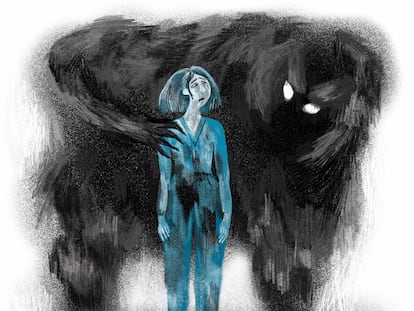What makes us feel cold when the temperature drops or when we have a mint?
A team of American scientists examined for the first time a type of protein from the group of ion channels that is behind the sensation of coldness

Warmth and coldness have been the topic of many hours of conversation—and countless minutes in the news— for as long as we can remember. Still, actual knowledge of what lies behind these perceptions is relatively recent, and it provides a fascinating insight into one of the most intimate aspects of our nature.
On the surface of our cells, proteins sensitive to changes in temperature are produced; when it is cold or hot, they open up to form a channel through which a flow of ions passes. This informs the cell of what is happening in the environment. “These biochemical antennas, which all living beings have, translate the physical signals of our surroundings and allow us to communicate with the outside,” explained Teresa Giráldez, an expert in these ion channels at the University of La Laguna in Tenerife, Spain. Understanding and regulating these antennae is of great interest to medicine, as it may be a way to modulate pain.
One of the phenomena that have been observed through the study of these channels is how some sensations could come from physical or chemical changes. Heat can be felt through an increase in temperature, but also when one eats something very spicy. This was discovered in the late 1990s by David Julius, one of the winners of the 2021 Nobel Prize in Medicine for his study of ion channels. Working with capsaicin, the molecule that makes chili peppers hot, he identified the TRPV1 receptor, the channel that explains the heat we feel when we eat something spicy or when we walk down the street in the middle of the summer. Later on, menthol, the chewing gum ingredient that makes the mouth feel cool, was used to identify the TRPM8 receptor, which is responsible for communicating cold.
These receptors allow us to maintain an adequate temperature by sending signals to make the blood vessels in our skin contract, helping to retain the warmth when it is cold, or dilate, to cool us down when it is hot. But they are also related to the sensation of pain and to the regulation of other essential processes. This explains why almost 18% of the drugs used today target the ion channels and why the accurate knowledge of how they work is a very promising factor for designing drugs that could make possible things like relieving a specific type of pain without the side effects of today’s analgesics. However, knowing precisely how this machinery works is not that easy.
Last year, a team of researchers led by Seok-Yong Lee, from Duke University, published a paper in the journal Science showing the structure of TRPM8 protein from mice in three states: open, intermediate and closed. As the structure of proteins provides information about their function and how they can fit with other molecules, knowing the structure of these positions is a step towards creating methods to act on these ion channels, with therapeutic potential against neuroinflammatory diseases or to manage pain.
The authors of the study achieved their results through cryo-electron microscopy, a technology that allows biomolecules in motion to be frozen and photographed at atomic resolution. These techniques, which earned their pioneers the Nobel Prize in 2017, “allow us to see these structures as if it was a movie,” explained Félix Viana, a researcher who also works with these channels at the Alicante Institute of Neurosciences, in Spain. “There are several published structures [of these proteins that regulate the feeling of cold] in different conformations, but the channel was always closed. What is new here is that for the first time it is seen in an open conformation; it’s like seeing the complete film,” he added.
Viana, who has studied these channels with the potential to prevent neuropathic pain associated with cancer treatments, said that “knowing the atomic structure of these channels is important, so a rational design of drugs can be made,” to reduce the trial and error aspect that still exists in the search for new medicines. However, the researcher pointed out that “there are other factors, in addition to the structure, that influence whether a drug is effective or not” and that make designing a drug a very complex task. “Julius identified the TRPV1 in 1997 and the pharmaceutical companies set out to find molecules for that channel. There are many patents, but they have not yet been approved, because there are side effects,” he continued. “In the specific case of this channel [associated with the perception of heat], many cause fever,” he explained.
Giráldez also believes that having molecular-level images of how this works will have practical applications. “If you know how these proteins work, and you know which amino acids you can modify in the protein, it would be like changing the nut of a machine when it’s broken,” she said. “You could treat people who have unexplained pain, and improve their quality of life,” she added. However, she also stressed the importance of this basic research to understand our nature and the way we feel and relate to our environment.
“The greater the basic knowledge of these mechanisms is, the better we’ll be able to attack the problems related to their functioning,” she concluded.
Sign up for our weekly newsletter to get more English-language news coverage from EL PAÍS USA Edition
Tu suscripción se está usando en otro dispositivo
¿Quieres añadir otro usuario a tu suscripción?
Si continúas leyendo en este dispositivo, no se podrá leer en el otro.
FlechaTu suscripción se está usando en otro dispositivo y solo puedes acceder a EL PAÍS desde un dispositivo a la vez.
Si quieres compartir tu cuenta, cambia tu suscripción a la modalidad Premium, así podrás añadir otro usuario. Cada uno accederá con su propia cuenta de email, lo que os permitirá personalizar vuestra experiencia en EL PAÍS.
¿Tienes una suscripción de empresa? Accede aquí para contratar más cuentas.
En el caso de no saber quién está usando tu cuenta, te recomendamos cambiar tu contraseña aquí.
Si decides continuar compartiendo tu cuenta, este mensaje se mostrará en tu dispositivo y en el de la otra persona que está usando tu cuenta de forma indefinida, afectando a tu experiencia de lectura. Puedes consultar aquí los términos y condiciones de la suscripción digital.
More information

The Mpemba effect: When hot water freezes faster than cold
Últimas noticias
Half of Scotland is in the hands of 420 property owners
Pinochet’s victims grapple with José Antonio Kast’s rise in Chile
Reinhard Genzel, Nobel laureate in physics: ‘One-minute videos will never give you the truth’
From digital curfews to blocking apps: How technology experts protect their children online
Most viewed
- Pablo Escobar’s hippos: A serious environmental problem, 40 years on
- Reinhard Genzel, Nobel laureate in physics: ‘One-minute videos will never give you the truth’
- Why we lost the habit of sleeping in two segments and how that changed our sense of time
- Charles Dubouloz, mountaineering star, retires at 36 with a farewell tour inspired by Walter Bonatti
- The Florida Keys tourist paradise is besieged by immigration agents: ‘We’ve never seen anything like this’










































